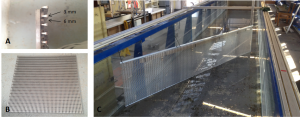Physical screens are usually installed at intakes to prevent fish entrainment and guide them towards bypass channels or other alternative routes. Although a variety of physical screens exist, how well they function has primarily been assessed for diadromous species (e.g. salmonid smolts). Resident or potamodromous species/ life stages have largely been ignored. Recent developments include the use of horizontal bar arrangements as opposed to the (traditional) vertical orientation, as the former benefits self-cleaning of screens and enables better escape of fish when impinged.
To address the above issues and aid in the development of successful screening methods, several experiments have been conducted in collaboration with the Environment Agency with juvenile chub (Squalius cephalus) and barbel (Barbus barbus). Under different discharge regimes, wedge-wire panel screens and bar racks with either horizontal or vertical bar alignment, were used. Their guidance efficiency as well as the behavioural response of both species was investigated. Results confirm the importance of the fish’s behavioural response (in particular avoidance) to screen hydrodynamics in the context of successful guidance.
Publications:
de Bie, Jasper, Peirson, Graeme, Kemp, Paul S. (2018). Effectiveness of horizontally and vertically oriented wedge-wire screens to guide downstream moving juvenile chub (Squalius cephalus). Ecological Engineering 123: 127-134. https://doi.org/10.1016/j.ecoleng.2018.07.038
People:
Dr Jasper de Bie
Dr Graeme Peirson
Prof Paul Kemp

